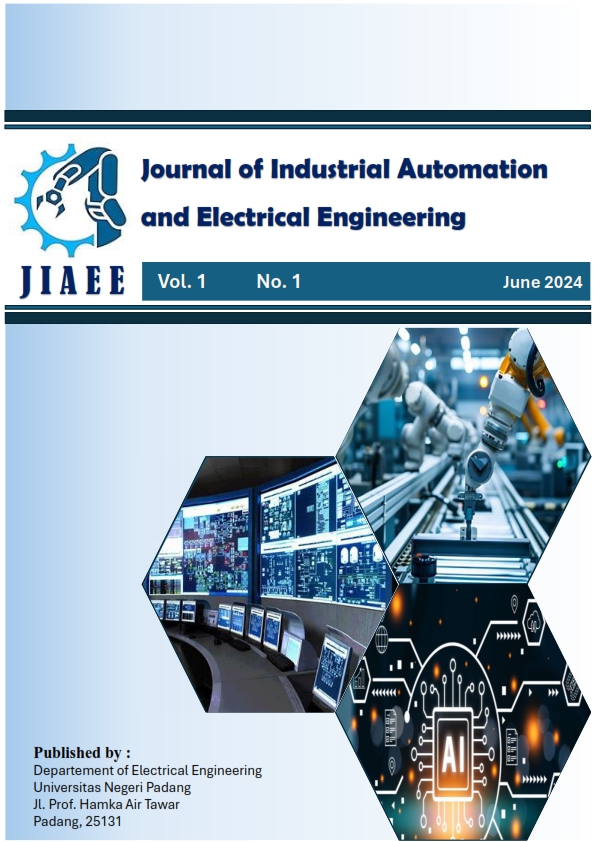Smart Room Control and Monitoring System Based on Internet of Things
Keywords:
Smart Room, Google Assistant, Internet of Things, NodeMCU Esp8266, BlynkAbstract
In this modern era, the development of Internet of Things technology has opened up opportunities to create a smarter home environment that is easily accessible from anywhere. This research aims to create and develop a smart room system that utilises the Blynk platform and Google Assistant to efficiently control and monitor devices in the room. This system allows users to control electronic devices such as lights, fans, and other household appliances through the Blynk application, manual switches and provides voice-based control capabilities using Google Assistant. This system is designed using NodeMCU Esp8266 microcontroller as the main controller, which is connected to sensors and equipment that are controlled in this tool to monitor and control room conditions. The Blynk app is used as the user interface for real-time control, while integration with Google Assistant allows control via voice commands. Tests of the system that have been carried out both using Blynk, manual switches and Google Assistant show that the device can respond to commands quickly and provide accurate feedback on the status of the device and room conditions. With this system, users can improve comfort and energy efficiency in their homes, as well as enjoy the convenience of controlling devices through various media, both mobile applications and voice commands. The system also provides opportunities for further future development of an integrated smart room ecosystem
Downloads
References
[1] C. T. Fandiansyah, M. S. Hadi, and R. S. D. Kartikasari, “Purwarupa Sistem Kendali Jarak Jauh Smart Room Berbasis Smartphone,” JASIEK (Jurnal Apl. Sains, Informasi, Elektron. dan Komputer), vol. 4, no. 1, pp. 41–54, 2022.
[2] N. H. L. Dewi, M. F. Rohmah, and S. Zahara, “Prototype Smart Home Dengan Modul Nodemcu Esp8266 Berbasis Internet of Things (Iot),” J. Tek. Inform., p. 3, 2019.
[3] S. Hadi, P. Dewi, R. P. M. D. Labib, and P. D. Widayaka, “Sistem Rumah Pintar Menggunakan Google Assistant dan Blynk Berbasis Internet of Things,” MATRIK J. Manajemen, Tek. Inform. dan Rekayasa Komput., vol. 21, no. 3, pp. 667–676, 2022.
[4] Saharuddin, Sabran, and Rahmayanti, “Penerapan Smart Room Berbasis Iot Menggunakan Mikrokontroler Node Mcu Di Jurusan Pendidikan Teknik Elektronika FT UNM,” ACM J. Emerg. Technol. Compuputing Sytem, vol. 16, no. 1, pp. 22–31, 2021.
[5] V. Alvianto Mardi Utomo, “Sistem Kontrol Lampu Dan Kipas Angin Dengan Google Assistant Berbasis IoT,” J. Elektron. dan Tek. Inform. Terap., vol. 1, no. 4, pp. 18–31, 2023.
[6] M. D. Faturalim and E. Nurraharjo, “Smart Room Menggunakan Metode Rso (Record Style Owner),” J. Inform. dan Rekayasa Elektron., vol. 5, no. 2, pp. 201–211, 2022.
[7] R. Rahma, R. Nasution, and E. Susanti, “Pemanfaatan Keunggulan Google Assistant untuk Pemantauan dan Pengendalian Smart Room The use of The Excellence of Google Assistant for Smart Room,” Sist. J. Sist. Inf., vol. 12, pp. 41–51, 2023.
[8] G. Shibghotullah, D. Kurnianto, and M. A. Amanaf, “Rancang Bangun Smart Room Menggunakan Bluetooth Berbasis Arduino,” Conf. Electr. Eng. Telemat. Ind. Technol. Creat. Media , vol. 1, no. 1, pp. 252–257, 2018.
[9] N. A. Z. M. Noar and M. M. Kamal, "The development of smart flood monitoring system using ultrasonic sensor with blynk applications", Measurement and Application (ICSIMA), 2017.
[10] B. Nugroho, R. -, and R. Kristiyono, “Aplikasi Esp8266 Sebagai Pengendali Smart Room,” Teknika, vol. 8, no. 1, pp. 55–64, 2023.
[11] Y. Perwej, K. Haq, F. Parwej, M. Mumdouh and M. Hassan, "The internet of things (IoT) and its application domains", International Journal of Computer Applications, vol. 97, no. 8887, pp. 182, 2019
[12] R. P. Gozal, A. Setiawan, and H. Khoeswanto, “Aplikasi SmartRoom Berbasis Blynk untuk Mengurangi Pemakaian Tenaga Listrik,” J. Teknol. Ind., vol. 8, no. 1, pp. 1–7, 2020.
[13] T. K. Gannavaram V, U. M. Kandhikonda, R. Bejgam, S. B. Keshipeddi and S. Sunkari, "A Brief Review on Internet of Things (IoT)", International Conference on Computer Communication and Informatics, pp. 1-6, 2021.
[14] M. A. Ashari and L. Lidyawati, “Iot Berbasis Sistem Smart Home Menggunakan Nodemcu V3,” J. Kaji. Tek. Elektro, vol. 3, no. 2, pp. 138–149, 2018.
[15] Y. K. Verma, M. Jagadeesh, P. M. Kumar, H. I. Younis and M. S. Adhikari, "Design of Real-Time GPS Tracker Using ESP-8266 With Blynk Application", International Conference on IoT Communication and Automation Technology (ICICAT), 2023.
[16] A. Seto, Z. Arifin, and S. Maharani, “Rancang Bangun Sistem Pengendali Suhu dan Kelembaban pada Miniatur Greenhouse menggunakan Mikrokontroler Atmega 8,” Pros. Semin. Tugas Akhir FMIPA UNMUL 2015, pp. 42–49, 2015.
[17]. H. Pangaribuan F. Cherli, I. L. Herin, “Voice Control Sebagai Pengendali Peralatan Elektronik Berbasis Nodemcu,” Tek. Ind. Komput. Dan Sains, vol. 1, no. 2715–6265, pp. 72–81, 2019.
[18] M. Nas et al., “Sistem Smart Room Menggunakan Voice Recognition Berbasis IoT,” Pros. 4th Semin. Nas. Penelit. Pengabdi. Kpd. Masy. 2020, pp. 141–146, 2020







